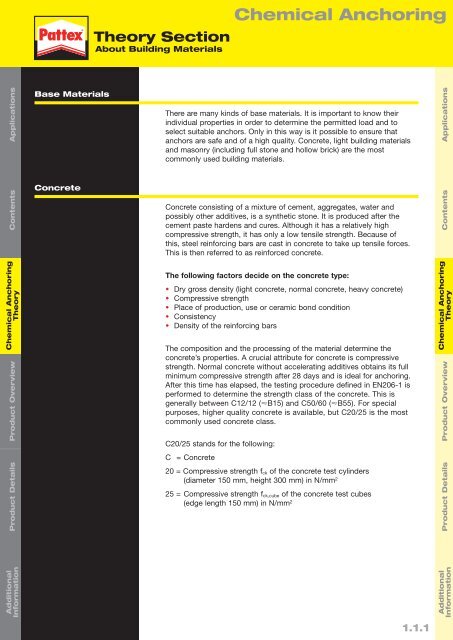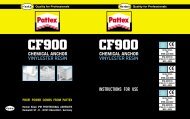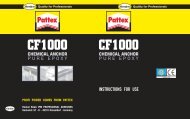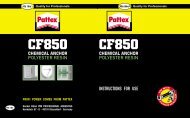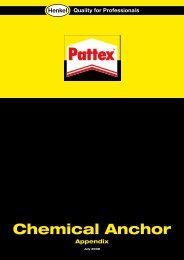Chemical Anchor Technical Handbook
Chemical Anchor Technical Handbook
Chemical Anchor Technical Handbook
You also want an ePaper? Increase the reach of your titles
YUMPU automatically turns print PDFs into web optimized ePapers that Google loves.
Theory Section<br />
About Building Materials<br />
<strong>Chemical</strong> <strong>Anchor</strong>ing<br />
Contents Applications<br />
Product Overview<br />
Base Materials<br />
Concrete<br />
There are many kinds of base materials. It is important to know their<br />
individual properties in order to determine the permitted load and to<br />
select suitable anchors. Only in this way is it possible to ensure that<br />
anchors are safe and of a high quality. Concrete, light building materials<br />
and masonry (including full stone and hollow brick) are the most<br />
commonly used building materials.<br />
Concrete consisting of a mixture of cement, aggregates, water and<br />
possibly other additives, is a synthetic stone. It is produced after the<br />
cement paste hardens and cures. Although it has a relatively high<br />
compressive strength, it has only a low tensile strength. Because of<br />
this, steel reinforcing bars are cast in concrete to take up tensile forces.<br />
This is then referred to as reinforced concrete.<br />
The following factors decide on the concrete type:<br />
•<br />
•<br />
•<br />
•<br />
•<br />
Dry gross density (light concrete, normal concrete, heavy concrete)<br />
Compressive strength<br />
Place of production, use or ceramic bond condition<br />
Consistency<br />
Density of the reinforcing bars<br />
The composition and the processing of the material determine the<br />
concrete’s properties. A crucial attribute for concrete is compressive<br />
strength. Normal concrete without accelerating additives obtains its full<br />
minimum compressive strength after 28 days and is ideal for anchoring.<br />
After this time has elapsed, the testing procedure defined in EN206-1 is<br />
performed to determine the strength class of the concrete. This is<br />
generally between C12/12 (B15) and C50/60 (B55). For special<br />
purposes, higher quality concrete is available, but C20/25 is the most<br />
commonly used concrete class.<br />
C20/25 stands for the following:<br />
C = Concrete<br />
20 = Compressive strength f ck of the concrete test cylinders<br />
(diameter 150 mm, height 300 mm) in N/mm 2<br />
25 = Compressive strength f ck,cube of the concrete test cubes<br />
(edge length 150 mm) in N/mm 2<br />
Additional<br />
Information<br />
Additional<br />
Information<br />
Product Details<br />
<strong>Chemical</strong> <strong>Anchor</strong>ing<br />
Theory<br />
Product Details<br />
Product Overview<br />
<strong>Chemical</strong> <strong>Anchor</strong>ing<br />
Theory<br />
Contents Applications<br />
1.1.1


